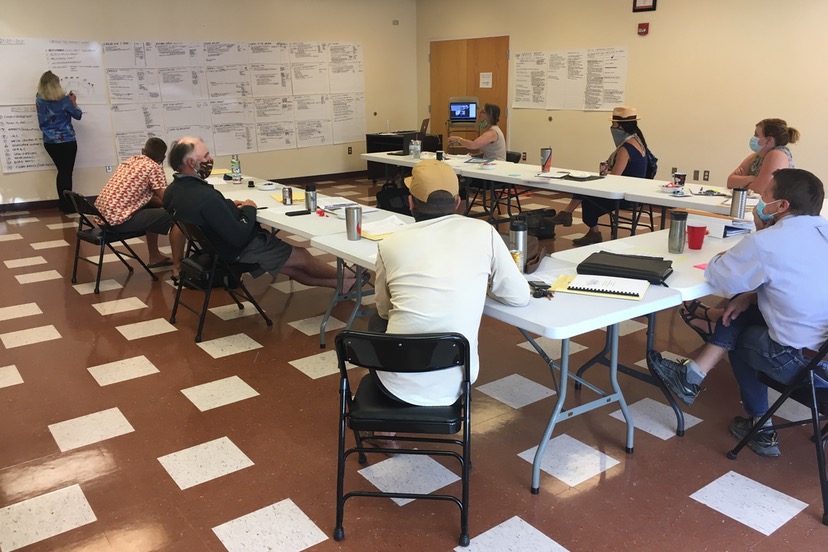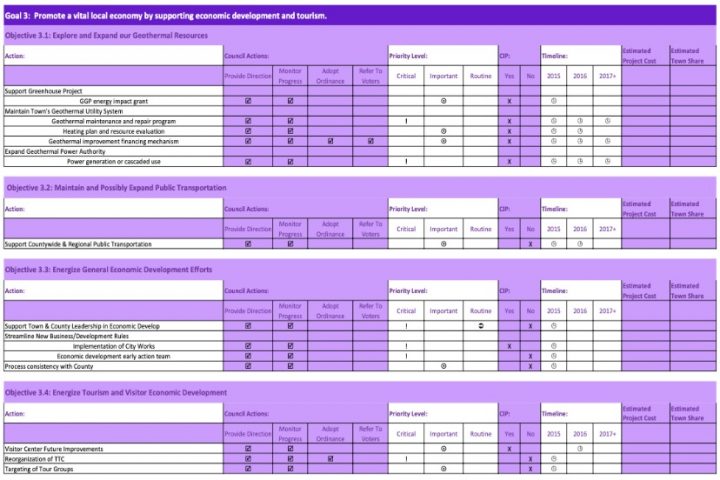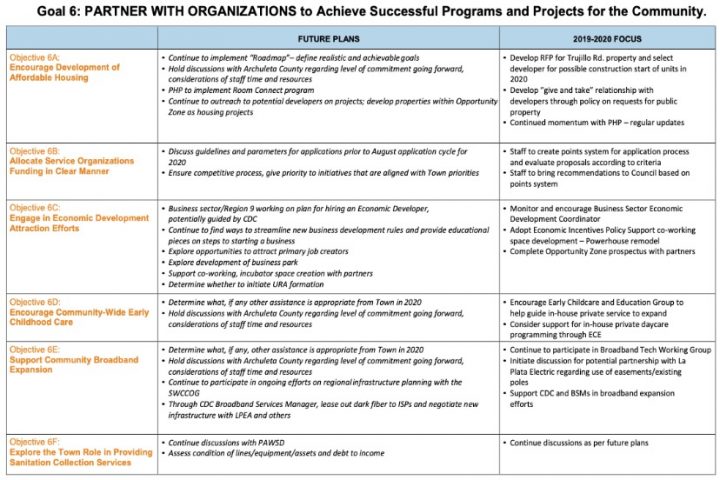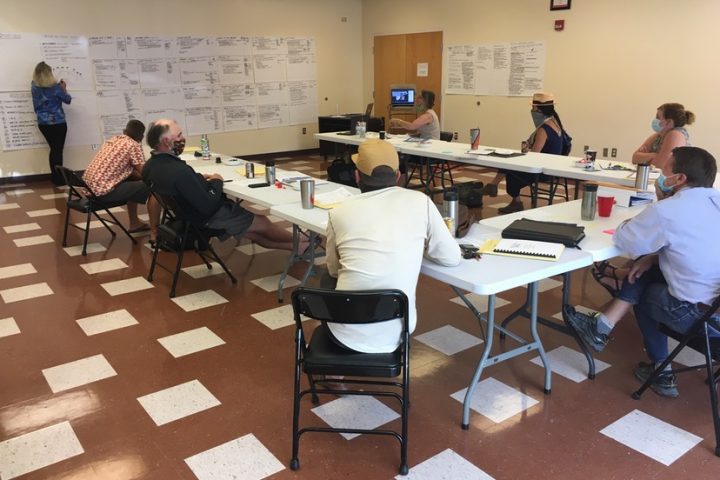As we noted in earlier installment of this editorial series, the Town Council has been holding annual ‘strategic planning retreats’ since 2014, to help the Council define ‘goals’ and ‘objectives’ as they spend millions of dollars each year providing various public services. This morning, I was reviewing the ‘Goals & Objectives’ from the 2014 retreat, a planning meeting that was facilitated (as I recall) by then-Town Manager Greg Schulte.
I counted 48 proposed “actions” focused around 14 larger “objectives” for 2014-2015. Here, for example, is one page from the resulting staff report, summarizing those goals, objectives and actions; their level of priority; and when they might be accomplished:
The Town Council deals basically in overall policies. The paid staff does the day-to-day work. These annual retreats supposedly lay out a work plan for the staff to follow. Supposedly. Looking through the 2014-2015 goals, some have been accomplished. Some have not, as of the summer of 2020.
The goals and objectives defined suring the annual retreats are mainly in addition to the normal operations of the Town staff and government, such as maintaining the streets, running recreation programs, collecting fees and taxes, providing police services, and so on.
So a list of 48 “actions” and 14 “objectives” was rather ambitious, in 2014. In my humble opinion.
Last year, the staff summary from the 2019 retreat discussions showed a slightly different layout, and perhaps a more ambitious agenda. The summary listed 143 “actions” spread over 56 “objectives.
Triple the number of important goals, compared to 2014?
Here’s just one page from the 15-page 2019 plan. An ambitious plan, to say the least.
At last Friday’s retreat, facilitator Yvonne Wilcox stated her intention to do things a bit differently this year. Knowing full well that a municipal government is unlikely to accomplish 143 sometimes-complex actions during the next couple of years, in addition to ordinary, everyday, required municipal functions, Ms. Wilcox told the Council she hoped to end up with no more that ten goals for the 2020-2021 tax-spending season.
She managed to get close to that number, although (as I wrote before) I left the retreat confused about exactly which “priorities” had made the list, and which had not.
I wonder if the Council members were also unclear.
Yesterday in Part Six, I discussed what appeared to be the Council’s “Number One” priority: Broadband.
Exactly what that term means, and exactly what a municipal government can accomplish towards that objective, was also not made fully clear during the retreat. But we know that the Council is very concerned about it, in the summer of 2020.
The goal that seemed to be second on the list of priorities was a thorough update to the Land Use and Development Code. The “LUDC”.
Curiously enough, this “priority” did not appear among the action items in 2014, nor in 2019. But this summer, it suddenly jumped to near the top of the list of very important municipal actions. Which is not to say that a thorough update to the LUDC is a new idea — just that it hasn’t seemed to be at the top of the staff’s list of jobs to accomplish.
Until now?
I had a chance to spend some time with the Town of Pagosa Springs Land Use and Development Code during my six months serving as a volunteer on the Town Planning Commission. In my amateur opinion, the LUDC is basically a well-conceived document that has a few issues with clarity, that could probably be cleared up with a few hours of work by a citizen group.
But besides the occasional lack of clarity, the Town LUDC has a much bigger problem. A land use code defines the various ways you can use your private property, mainly by defining what you cannot do with it. Very little of the language in the Town’s land use code is aimed at encouraging the development of property; the rules are instead aimed at protecting the rights of existing property owners, who own property developed perhaps 50 years ago. Or 100 years ago.
If, however, we look carefully at how our community has developed over the past 30 years — since the LUDC has become a key controlling force — we notice that the vast majority of homes constructed have been priced for upper-middle-class retirees. Almost no housing has been built in the core residential areas aimed at middle-class and lower-middle-class families and individuals over the past 30 years.
But those middle-class and lower-middle-class residents are exactly the people who keep our economy running.
Please understand, I have nothing against retirees — some of my best friends are retirees — but they don’t keep the grocery shelves stocked, and they don’t make motel room beds, and they don’t flip the burgers.
The Town government has been talking about addressing this problem since at least 2004, when we first started publishing the Pagosa Daily Post. But the Town government has done almost nothing to address the problem, other than help pay for three different consultant studies that clearly told us we have a serious problem.
Yesterday, we published a real estate report by one of the community’s more successful realtors, Lee Riley. Here’s an excerpt from that article:
Now for the latest real estate news. This is the busiest I have seen the market since 2005. Pending sales are through the roof. There are currently 219 properties under contract, compared to 128 last year at this time. Multiple offers are much more common than I’ve seen in the past.
Inventory is way down, which keeps prices very strong due to supply and demand. This is great for sellers, but not so good for buyers.
The big jump in activity is due to a combination of several factors. Interest rates remain at unheard of lows. A 30-year fixed-rate mortgage is currently 3.0% and a 15-year is at 2.5%. We’re seeing an exodus of people from the big city headed for small town charm, a safer place to live, less crime, and less stress. This is creating a perfect storm for a real estate boom.
If we had a housing crisis already in 2019, it might appear that the problem is only getting worse during — and perhaps as a result of — the COVID pandemic. A perfect storm?
We can’t place blame only on the Town (and County) land use codes for the powerful market forces that are currently driving up housing costs. But clearly, we have a problem — if the LUDC hasn’t been updated in the past 15 years, specifically to try and address the current crisis.
Is this why the Town Council, this year, is suddenly so concerned about an LUDC update?




